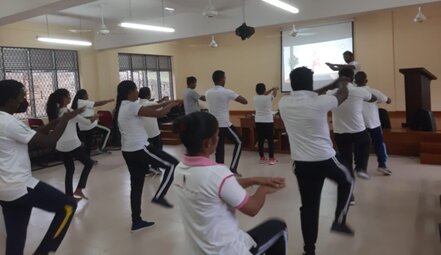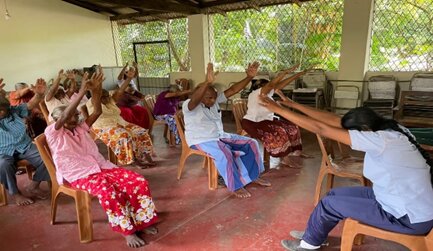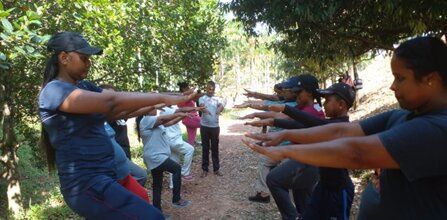Making fitness fun
An initiative by the Directorate of Non-Communicable Disease for a healthy tomorrow
By Dr Tasneem Naina Marikkar
The benefits of physical activity are well known and range from physical and psychological benefits to all ages of the population. According to the recommendations of the World Health Organization (WHO), persons aged 18 to 64 should do at least 150 to 300 minutes of moderate-intensity or 75 to 150 minutes of vigorous-intensity aerobic physical activity throughout the week. Additionally, regular muscle-strengthening activities that involve all major muscle groups on two or more days per week are recommended, while minimizing sedentary behaviour.
Let’s beat Non-Communicable Diseases by moving more!
The best time to exercise is when it works for you.
But how you overcome this inclination towards sedentary behaviour? How do you make healthy choices regarding your body and mind?
The key importance of leaving your couch towards a healthier tomorrow lies in making the fitness regime fun.
Repeated exposure to the same stimulus could cause a decrease in the involvement and enjoyment in your routine, therefore you should introduce novel ideas to your daily physical activity routine.
Let’s look at some ways you can incorporate fun concepts into the different settings of your lives. We at the Directorate of Non-Communicable Disease (NCD) call it “the setting approach”.
Creating a healthy fun workplace

One of the main excuses for not engaging in physical activity is lack of time due to work. So what’s stopping you from creating an active environment at your workplace?
The Directorate of NCD has considered workplace an important stepping stone towards decreasing the sedentary behaviour of the workforce and is in the process of finalizing guidelines for all policy makers on how to integrate an active work atmosphere in all institutions.
Sedentary behaviour is when people remain seated or in a reclined position continuously for long durations. This is how we are mostly at work, glued to our screens and chairs. To overcome this sedentary behaviour at work, the concept of active breaks was introduced for a positive behavioural change. Many active break videos and public audio announcements with exercise scripts have been created in collaboration with the Sri Lanka Sports Medical Association that can be downloaded from the NCD unit official website: http://www.ncd.health.gov.lk.

These include seated, standing and group exercise videos which can be displayed on the screen with background music, enabling participants to easily follow the movements and the beats. If screens are not available an audio recording has been prepared in both Sinhala and Tamil, which can be broadcast via a speaker or in small groups using a phone.
So let’s create a culture of movement at the workplace. Some of the ways we can individually promote physical activity at workplace settings are: parking the vehicle at the farthest parking spot; taking the stairs instead of the elevator; communicating with your colleagues by walking over to their desks instead of sending emails or short messages; taking the longest route to meet a colleague; keeping an alarm to remind you to engage in short activity breaks; rearranging your work station so that you need to stand up to reach for any tools you regularly use; and attending to calls while walking in the hallway. These simple methods could be achieved through a workplace wellness strategy.
It is vital that the policy makers at all institutions support and motivate their staff towards healthy choices as this will improve their work performance, productivity and reduce absenteeism, an overall benefit for both the employer and employee.
Walking buddies and competitions can be held at the workplace, celebrating special days related to fitness and physical activity. This will inspire the institutional workforce to make healthy choices to overcome the resistance of being plastered to a chair.
An active future generation
Another setting targeted by the Directorate of NCD is schools, taking into consideration the increasing tendency towards obesity among children. The COVID-19 pandemic, which put a pause on outdoor play facilities has resulted in most children being glued to the phone, television or the computer for long periods. Today they are facing the ill effects of excessive screen time.
Physical education and playtime in schools provide children with opportunities of being physically active. There is a need to advocate to all relevant stakeholders the importance of providing children with opportunities for sports and play. Parents, teachers, administrators of schools, policy makers in health and education need to be aware of the high rise in sedentary behaviour and obesity, and promote dynamic strategies and interventions to improve physical activity levels . The school setting is very important as it plays a pivotal role in promoting a mind-set change in physical activity for children of all ages, imperative to their physical and mental well-being.
So how can we draw away children from televisions and smart phones and guide them to make healthy choices? It has been found that only a small percentage of children meet the minimum recommendations of physical activity. The Directorate of NCD along with its stakeholders, including the Ministry of Education, have taken steps to revitalize the morning exercise sessions in schools and have produced separate customized advocacy videos and posters for teachers, parents and students.
We need to promote more active play/active recess, active commuting to and from school and active physical education lessons and integrate all these components to see a positive behavioural trend. We need to make sure we have a competent and skilled workforce who can offer their expertise to children in regard to physical education. This can be achieved through training, workshops and guidelines.
An active environment needs to be inculcated into school as it has been shown that increased access to play grounds and parks correlates positively to engagement in physical activity.
Children need to engage in a variety of types and intensities of physical activity, vital for the development of muscular fitness, bone strength and agility. The school setting can be used to inculcate healthy lifestyle choices from school-age to adolescence. The benefits of such choices is reaped in adulthood with less susceptible to non-communicable diseases in the future. The development of multi-woven interventions are vital to change children’s physical activity habits.
We need to come out of the thought frame that time taken for physical activity will come at the expense of getting good grades and accept that physical activity will promote and favour better academic performances.
A community that moves towards battling NCDs

According to the 2015 STEPS Survey one in three adults do not engage in physical activity. The Directorate of NCD has identified physical inactivity as an important risk factor that needs to be addressed through behavioural changes. In order to combat this important risk factor for NCDs, a TOT (training the trainer) manual on promoting physical activity, was formulated by the Directorate of NCD in collaboration with Sri Lanka Sports Medical Association and World Health Organization, and other relevant stakeholders. The TOT programs are conducted for district focal points, who are Medical Officers of Non-Communicable Diseases (MO NCD) and Healthy Life-Style Centre (HLC) Staff, on how they can promote and train clients of the Healthy Life Style centres in carrying out their own exercise sessions. This helps health care staff to guide the community on choosing the correct set of recommendations and how to promote physical activity within the community, including motivational behavioural changes. It also helps debunk the various myths associated with physical activity.
Tailor-made programs are carried out by the Healthy Lifestyle Centre staff on specific days in their hospital and clients are advised to participate and enhance their physical activity performance. Community oriented interventions need to be sustained for a period of time as we need to change the knowledge and attitudes of the community till they are receptive to the message, leading to a gradual increase in physical activity performances of a community in a stepwise approach.

Once the clients are trained, it’s important to emphasize the value of creating their own personalized exercise programs suitable for their time schedule and how to monitor their progress of change, which is imperative for a sustainable exercise program. Physical activity is also promoted through Mother Support Groups, Happy Villages, Community Service Officers and various other platforms enabling us to access all walks of life to create an active and healthy Sri Lanka.
Become part of move more trend! It will cultivate healthy lifestyles and save lives. As boxer Muhammed Ali said, “The only limitations one has are the ones they place on themselves.”
-Dr.Tasneem Naina Marikkar is Medical Officer, Directorate of Non-Communicable Diseases Ministry of Health. Pictures -Directorate of Non-Communicable Diseases Ministry of Health



Comments are closed, but trackbacks and pingbacks are open.